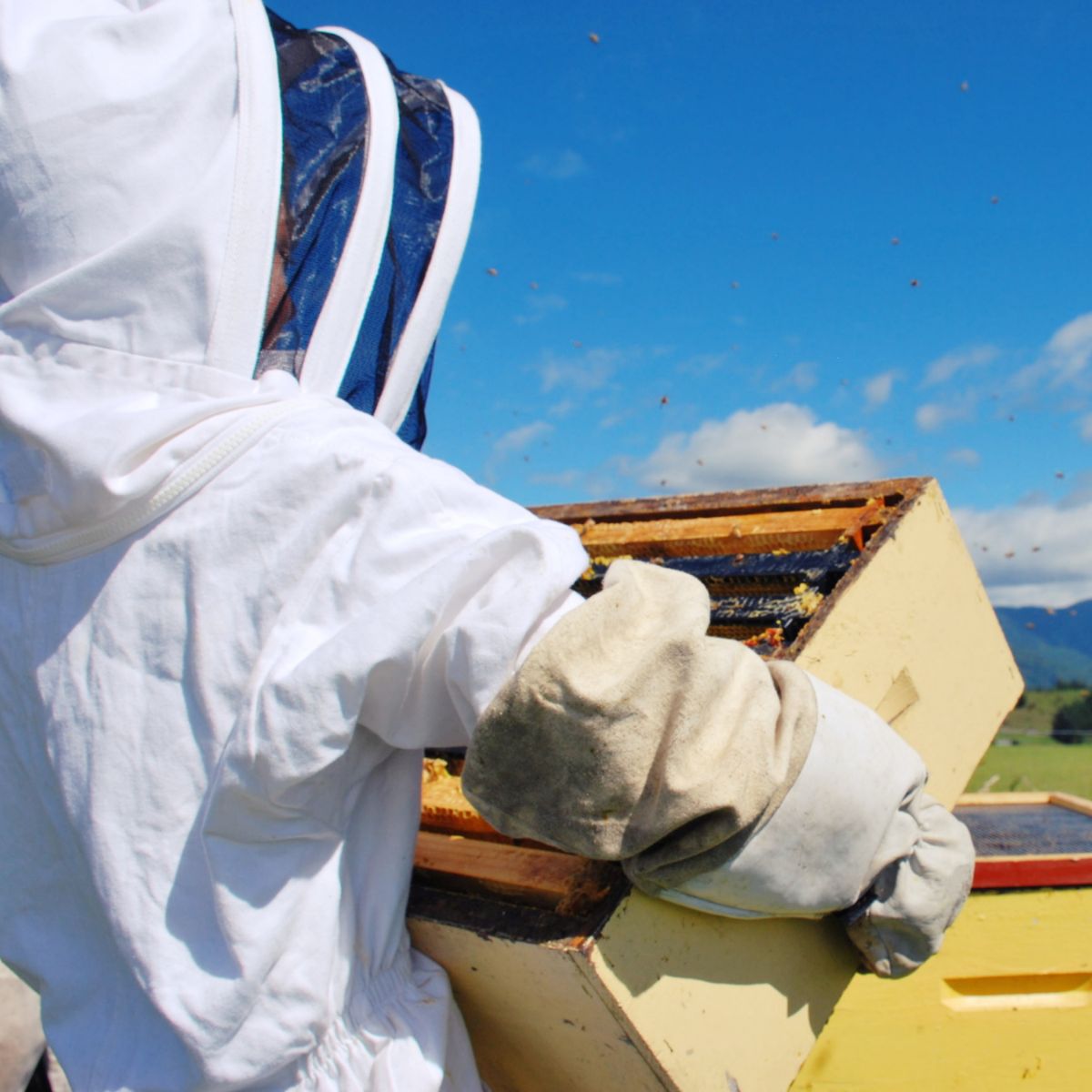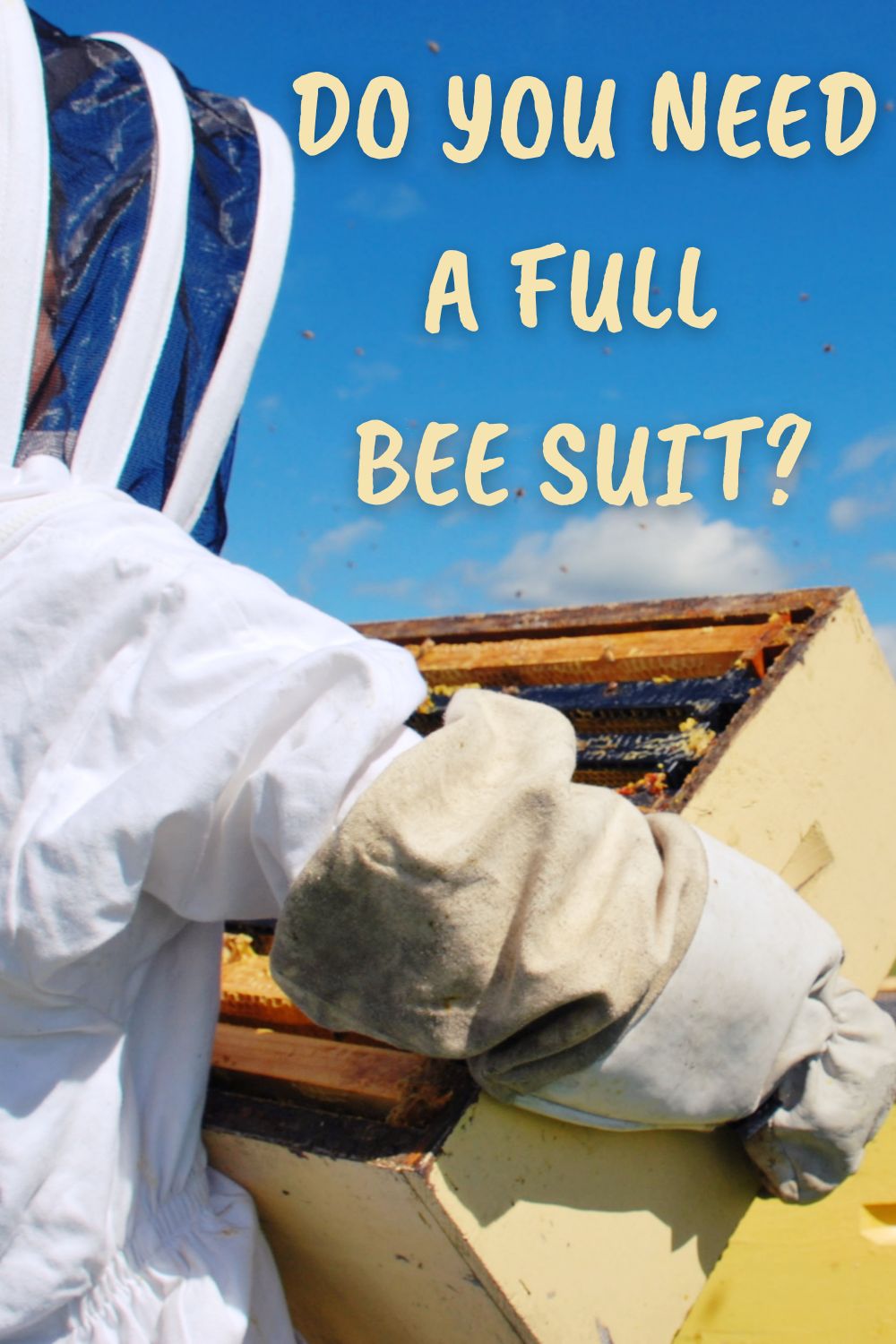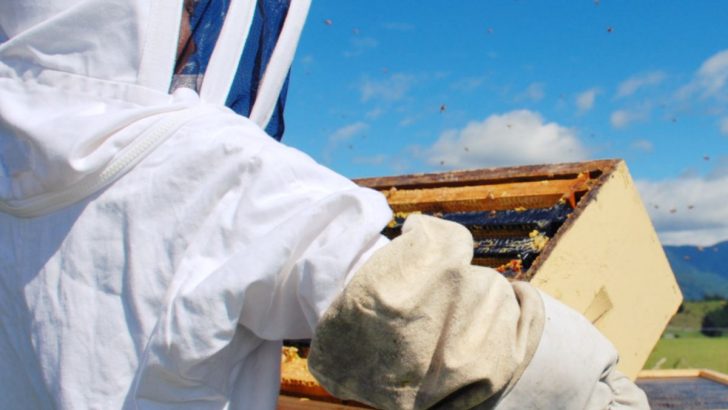Do you need a full bee suit? If you have started the fine art of beekeeping, you may have questioned whether or not you really need to wear a full bee suit. The truth is, there isn’t a one-size-fits-all answer, but rather a matter of opinion and location. Still, we have some facts that you may want to consider before deciding for yourself whether or not you need a full bee suit.
Many veteran beekeepers find using a full bee suit unnecessary; however, you may wish to invest in one if you are new to working with bees. Bees react badly to the carbon monoxide expelled in human breath, and this could result in a sting and a possible allergic reaction.

Do You Need A Full Bee Suit?
Experienced beekeepers understand the importance of safety for both the bees and the keeper. Some will use beekeeping jackets, even if they don’t use a full suit. Some may have used full sting protection when they were newer, but have since determined they don’t need as much. Some will choose only to wear a beekeeping veil. With all the different options, it’s easy to see why you might be confused if you’re new.
Whether you are new to beekeeping or a pro, wearing protective gear is a must, particularly at specific times of the year and in certain locations where more dangerous bees are found. Let’s look at what makes an optimal bee suit and what you can skimp on if you are feeling brave.
What is a full bee suit?
A full bee suit usually consists of the following:
- A heavy bee jacket with a zip and elastic at the end of the sleeves
- Heavy trousers with elastic at the bottom
- Gloves (nitrile gloves)
- A hat
- A bee veil (hooded veil)
- Heavy work boots
In the past, bee suits were available primarily in separate parts, so you could purchase a jacket alone or trousers alone. Today, most are in a coverall style, so a jacket and trousers are attached. It is essential that the material used for your bee suit is heavy. You will get used to the weight of it in time and it won’t feel as cumbersome.
What are bee suits made from?
Bee suits are designed to stop you, the beekeeper, from being stung. Over the years, a few different materials have been used. The three common materials used for bee suits are:
- cotton
- nylon
- mesh
Cotton bee suits
Cotton has been the most commonly used bee suit material for hundreds of years, and for good reason.
Although it can get pretty warm in a cotton suit, the material is thick enough that a sting will most likely not reach your skin.
Nylon bee suits
Nylon is a material that has been used more recently. It is thinner than cotton but is slippery. That means that a bee trying to sting you will probably slip off before having any success. One issue with nylon is that it is even hotter than cotton and does not breathe well.
In the summer heat, your sweat will make it stick to you, and you will get extremely hot while tending your bees.
Mesh bee suits
Mesh is another option for bee suit material. It is not very commonly used, although it can be used with good effect. A suit needs many layers of mesh to work well.
While a bee suit made from mesh will be breathable and deflect most stings, a downside is that it will not last as long as a cotton suit or be made with as much precision.
Why Do Beekeepers Need Protective Clothing?
Michelle Leske, an avid beekeeper in Johannesburg, South Africa, explains that protective clothing is of great importance when working with bees. Bee species can be extremely dangerous depending on where you live, and it is simply not worth taking the risk.
The most dangerous bees are Africanized Honey Bees, also known as killer bees. When an Africanized Honey Bee feels threatened, it has the capacity to kill a human being. On average, these bees kill one or two human beings per year. They are also aggressive with other bee species. They have been known to invade European hives, kill the queen and insert their own queen in her place.
Honey bees will typically only attack to protect their hive. There are, however, a few other triggers that could cause them to become aggressive. Some of these include:
- Severe disturbance outside their hive
- Vibrations
- Alarm pheromone
- Carbon dioxide
- Hair
- Dark colors
Most of these can be traced to natural predators, like bears, who have dark fur and tend to raid beehives. Humans often trigger the same attack reaction in bees. Even if we are gently inspecting the hive, we may cause a defense response and incite an attack. This is when protective clothing comes in handy.
Is It Safe to Work Without a Bee Suit?
Bee suits are designed to protect the beekeeper from stings. However, bee suits can be hot and uncomfortable to wear, and they can limit a beekeeper’s range of motion. As a result, some beekeepers choose to work without bee suits, relying on their experience and knowledge of bee behavior to keep them safe.
While this approach can be effective, it is important to remember that bees are unpredictable creatures, and even the most experienced beekeeper can be unexpectedly stung. For this reason, it is always best to err on the side of caution and wear a bee suit when working with bees.
Timing matters
When colony numbers are low in early spring and bees are a little more placid, a full bee suit may feel like overkill. But inspecting the same hives in mid-summer, when bees are most active, and colony numbers are high, will give you a very different picture.
Most stings can be easily managed by scraping them away with a nail or other flat object, but a sting to the face or hand may cause more pain and discomfort than we would like.
Even veteran beekeepers tend to protect their heads with a veil. This will stop bees from stinging anywhere on the face, but especially near the eyes.
A sting on the hand may not be as painful as one to the face but could render you a little less agile than usual. Gloves tend to limit our fine movements with the hives, but it’s a good idea to wear them to protect yourself if it’s mid-summer.
Now that you see the importance of a bee suit, you also need to learn how to care for it properly. They don’t come cheap and you want to keep them in good shape and working for you for as long as possible.
How to care for your bee suit
Have you ever noticed that bee suits are white or light in color? This is because bees are incited to aggression by dark colors. Dark colors are usually associated with animals in nature that may want to attack the hive, so it makes sense that bees would want to get rid of any potential predator.
If you are washing your bee suit, stay away from products that whiten your clothes. Many detergents use UV whiteners. Since bees see in UV colors, they could be attracted to your white bee suit instead of being calmed by it.
Be sure to mend your bee suit whenever you notice a hole or tear. Any opening is an opportunity for a bee to enter and deliver a sting.
Wash your suit regularly. When a bee delivers a sting, the sting continues to emit an alarm pheromone. This attracts other bees to join in the assault, even if the initial sting was delivered days before. It may help to rinse your suit in vinegar if it has received a few stings because this can help neutralize the pheromone.
If you are new to washing your bee suit, here is a simple step-by-step:
- Remove all items from the pockets
- Take off the veil
- Pre-wash or treat stains
- Do up zippers
- Loosen cords
- Wash in the washing machine
- Hang up to air dry
If you are still on the fence about using a full bee suit, it’s better to be tentative rather than careless. New beekeepers should make use of the full bee suits available until they feel confident enough to choose which protective gear to stick with. No matter how confident you are with beekeeping, you should protect your face and head at all times and protect your hands, especially at times of peak bee activity.






Best Beekeeping Starter Kit For New Beekeepers
Thursday 10th of November 2022
[…] bee suit – As a beginner, it is preferable to use a full suit rather than just a veil. Suits made from thicker material are preferable to thin material that the […]
Beekeeping For Beginners - Everything You Need To Know To Start Raising Bees
Thursday 10th of November 2022
[…] Bee Suit – part of the necessary PPE for a beekeeper (should you wear a full bee suit?) […]
Mann Lake Beekeeping Supplies Every Beekeeper Needs
Thursday 10th of November 2022
[…] Related: do you need a full bee suit? […]